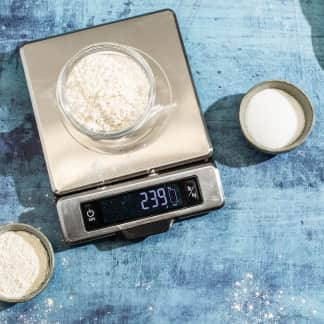The best kitchen timers are simple and easy to read and hear, with clearly labeled buttons, big digital screens, and alerts that are audible and/or visible from across the room. They often have extra features (such as stopwatch functions and memory settings) or adjustable settings to increase their usefulness. We especially like two models. The ThermoWorks Extra Big & Loud Timer is our top pick for cooks who want to track only one thing at a time. For cooks who want the ability to track multiple things with one timer, we currently recommend the ThermoWorks TimeStack.
How to Clean a Kitchen Timer Without Damaging It
Most models will stop working if they get wet. Here’s the best way to get your timer squeaky clean.You can use the timers on your smartphone, smart speaker, oven, or microwave—but there are good reasons to have a dedicated kitchen timer. Unlike most of the alternatives, a timer can be carried into another room so that it’s always visible and within earshot. A kitchen timer is also often easier to set than the timers on appliances, and you don’t have to worry about dirtying your phone with food.

In a busy kitchen, there's no substitute for a dedicated kitchen timer.
We prefer digital models to old-fashioned dial-face timers because they tend to be more precise, easier to set, and easier to read. The simplest digital models track a single set time and beep when that time is up. Most are considerably more complex. Many are “multiple-event,” which means they can track multiple times simultaneously. Most can count up (like a stopwatch) in addition to down. It’s also common for timers to have adjustable volume settings (sometimes including a silent setting) and flashing lights so that there’s a visual alert, too.
What to Look For
- Accuracy: Fortunately, you don’t have to look very hard to find an accurate timer. Every model we tested was accurate.
- Tilted Display with Large Digits: Timers with tilted displays were the easiest to read; the best models were wedge-shaped or had kickstands. We also preferred screens with big, easy-to-read digits.

Timers with tilted faces (right) were easier to read than timers with near-vertical faces (left).
- Clear Differentiation Between Events: When using a multiple-event timer, you don’t want to accidentally clear an active event while adjusting another. The screens of the dual, triple, and quad timers we tested displayed each of their events simultaneously. (Previous models we tested required scrolling, which we found untenable.) One model featured separate “set” and “start/stop” buttons for each event. Many of the multiple-event timers also had unique patterns of beeps and/or visual alerts and indications on their screens that helped us differentiate between the events.
- Adjustable Volume Levels: Many models had two or more volume settings, so you can accommodate your personal preferences or adjust to different noise levels in your kitchen. Some could be set to silent, which some cooks prefer. We found silent settings most helpful on the models that had big visual alerts.
- Visual Alerts: For people who are hard of hearing and anyone who works in a noisy kitchen, a flashing display or blinking light is essential. Unfortunately, some of the timers’ visual alerts were easy to miss. We preferred models with flashing digital screens. Additional flashing lights on the body of the timer also helped draw our attention.

Timers with digital screens that flash are easy to see from across the room. On this multiple-event timer from OXO, it's easy to tell which of its three timers is done.
- Screens That Track Elapsed Time: When many models reach 00:00:00, they will start counting up. That way you know, for example, that your brownies have baked an extra 2 minutes or that your bread has proofed 20 minutes too long.

Our favorite models track how much time has elapsed after the timer beeps (left). That way we know exactly how much longer than intended our food has cooked. We prefer them to models that simply flash 00:00 after the timer goes off (right).
Nice to Have
- Full Keypads with Numbers: To set time, some of the models we tested featured full keypads with buttons labeled “0” through “9,” while others had one button each for hours, minutes, and sometimes seconds. Models without full keypads took longer to set, especially if we accidentally overshot our target time. On average, it took us about 5 seconds to set the keypad timers and 11 seconds to set those without full keypads.
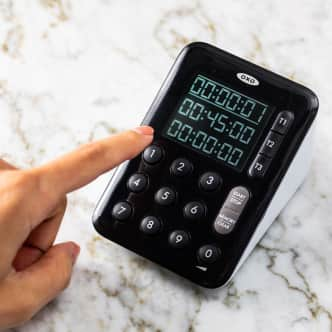
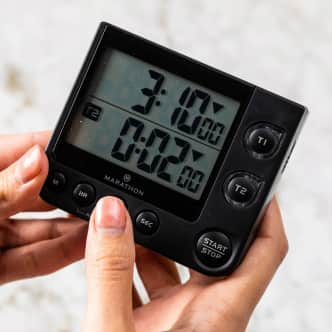
If a timer has a full keypad (left), you can simply type in the desired time. On models that simply have a button for hours, minutes, and seconds (right), you have to press down and scroll up. We liked both styles, but it was quicker and easier to use models with keypads.
- Voice Recordings: On multiple-event models, it can be hard to remember which event corresponds to each of the foods you’re making. One model we tested had a clever solution: voice recordings. You can record yourself saying short messages, such as “macaroni and cheese” or “check the lasagna,” which then replace the timer’s usual beeps. It took us a few tries to get the hang of making those recordings, but it could be a game changer for busy (or forgetful) cooks.
- Memory Functions: For recipes that you prepare frequently, the times can be easily preprogrammed and recalled by pressing a single button.
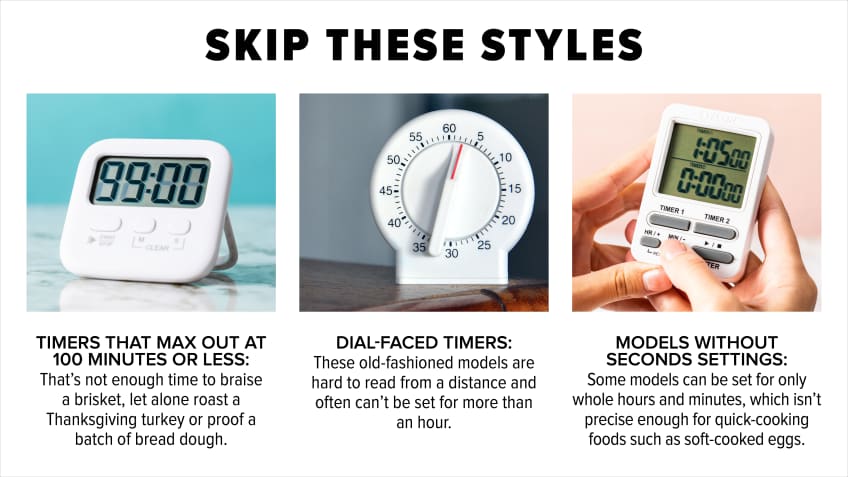
What to Avoid
- Dial-Faced Timers: They are less precise than digital timers with buttons, and they often make an annoying ticking noise the entire time they’re in use.
- Models with Short Time Limits: Models that can’t be set for longer than 60 or 90 minutes won’t cut it for many cooking projects. A big holiday turkey cooks for more than 2 hours, and simple braises or low-and-slow smoked ribs cook for much longer.
- Models Without Seconds Settings: All the timers we tested had screens that reported hours, minutes, and seconds. One of them could be set for only full hours and minutes. For many recipes, the ability to set seconds is essential. Our Soft-Cooked Eggs, for example, cook for exactly 6 minutes and 30 seconds, and whisking the sugar-egg mixture for three 30-second intervals is one key to making our Perfect Chocolate Chip Cookies.
- Confusing Buttons That Perform Multiple Functions: Many of the timers lacked a dedicated “clear” button and instead are reset by pressing the hour and minute buttons in unison. We didn’t mind that because the buttons were clearly labeled and we knew what to do when. But one model had buttons that seemed to do everything and nothing. Pressing the “start/stop” button sometimes caused one or all three of its events to start or stop—but it sometimes recalled the last set event. When one tester used that model to set a single event, it took her more than 90 seconds to figure it out.
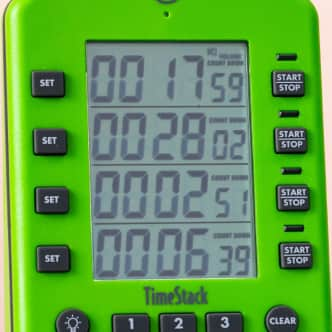
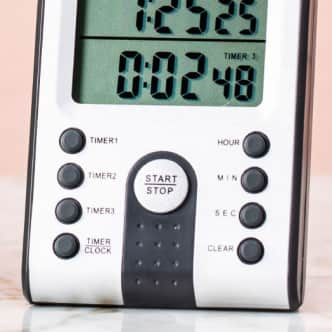
Models with big, clearly labeled buttons (left) were easy to use. Timers with tiny buttons (right) were confusing to operate, and we always worried that we would accidentally clear or reset the wrong event.
The Tests:
- Test accuracy, comparing times against the Official U.S. Time as reported by the National Institute of Standards and Technology
- Multiple-event models only: Set multiple events simultaneously
- Record how long it takes to stop, clear, and reset an event
- Use while preparing pizza dough
- Ask an additional person to set each model for 45 seconds
- Smear with flour and pizza dough; set aside for 24 hours; and then clean with a wet, soapy dish towel
- Test heat resistance by placing near a hot oven and a stovetop burner set to high heat
- Knock from the counter to the floor five times
- Repeat the accuracy test following the durability tests
- Evaluate additional features where applicable
How We Rated:
- Accuracy: We tested whether the timers were accurate. On multiple-event models, we tested the accuracy of each individual event.
- Ease of Use: We considered how easy it was to set, pause, clear, and reset the timers. We also considered the usefulness of additional settings and features.
- Display and Alerts: We evaluated the legibility of the digital screens and buttons. We also considered how visible and audible the alerts were and if they could be adjusted.
- Cleanup and Durability: We assessed how easy it was to clean the timers and whether they were sturdy and durable. We also considered whether they were splash-proof or splash-resistant.


 Buy at ThermoWorks
Buy at ThermoWorks













